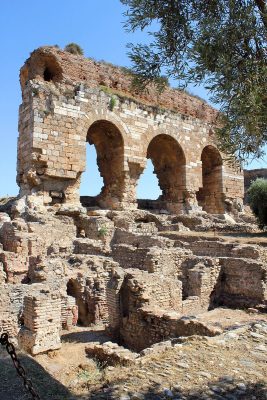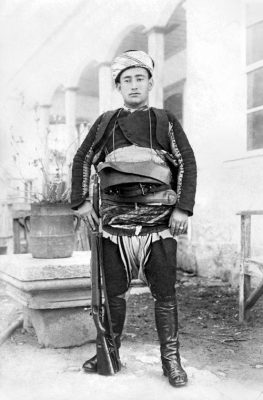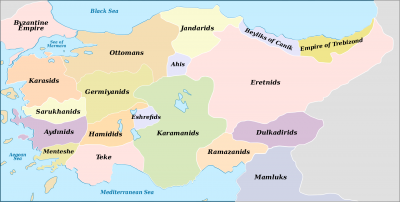The city is located at the heart of the lower valley of Büyük Menderes River (ancient Meander River) at a commanding position for the region extending from the uplands of the valley down to the seacoast.
Toponym
The original Greek name of the ancient city was Tralleis (latinized: Tralles).
The name of the province, the sancak and the kaza of Aydın derives from the principality of the Aydınoğulları, who ruled the region before the Ottomans (in Greek: Αϊδίνιο – Aidinio). Aydın is a Turkish male and female given name meaning ‘bright’, ‘clear’ or ‘educated’. The first name also occurs very often as a family name.

City of Aydın / Αϊδίνιο – Aydinio / Τράλλεις – Tralleis
History
Antiquity
According to Strabo Tralleis was founded by the Argives and Trallians. Along with the rest of Lydia, the city fell to the Persian Empire. In 334 B.C., Tralleis surrendered to Alexander the Great without resistance and therefore was not sacked. Alexander’s general Antigonus held the city from 313 to 301 B.C. and later the Seleucids held the city until 190 B.C. when it fell to Pergamon. From 133 to 129 B.C., the city supported Aristonicus of Pergamon, a pretender to the Pergamene throne, against the Romans. After the Romans defeated him, they revoked the city’s right to mint coins.
Tralles was a conventus for a time under the Roman Republic, but Ephesus later took over that position. The city was taken by rebels during the Mithridatic War during which many Roman inhabitants were killed. Tralles suffered greatly from an earthquake in 26 B.C. Augustus provided funds for its reconstruction after which the city thanked him by renaming itself Caesarea.
Strabo describes the city as a prosperous trading center, listing famous residents of the city, including Pythodoros (native of Nysa), and orators Damasus Scombrus and Dionysocles. Alexander of Tralles of Lydia was one of the most eminent of the ancient physicians. Several centuries later, Anthemius of Tralles, architect of the Hagia Sophia in Constantinople, was born in Tralles.
Christianity and Byzantine era
An early bishop Polybius (fl. ca. 105) is attested by a letter from Saint Ignatius of Antioch to the church at Tralles. The city was officially Christianized, along with the rest of Caria, early after the conversion of Constantine, at which time the see was confirmed.
After the Battle of Manzikert in 1071, with the Byzantine Empire in civil chaos, the Seljuks took Tralles for the first time, but Alexios I Komnenos re-captured the city for Byzantium in the later half of the eleventh century.
By the 13th century, the city lay in ruins. In 1278, Andronikos II Palaiologos decided to rebuild and repopulate it, now to be renamed Andronikopolis or Palaiologopolis, with the aim of forming a bulwark against Turkish encroachment in the area. The megas domestikos Michael Tarchaneiotes was given the task: he rebuilt the walls and settled 36,000 people from the surrounding regions. 13th century Byzantine settlement policy along the Meander Valley notably involved the Turkic Cumans. Nevertheless, Turkish attacks resumed soon after. The city was besieged and, lacking sufficient supplies and access to water, captured by the beylik of Menteshe (Menteşe) in 1284. The city suffered extensive destruction and part of its inhabitants were massacred. Moreover, over 20,000 inhabitants were sold off as slaves.
Turkic and Ottoman era
Under the rule of Menteshe, whose lands extended towards the south, the city was renamed as Güzelhisar (“beautiful castle”). The city was later taken over by the Aydinids, who made it one of their principal settlements, but not the capital.
The Beylik of Aydin was founded in the region in 1307 and they ruled the lands north of Büyük Menderes River up to and including Smyrna. During the first half of the 14th century, Aydinids were as active as the Ottomans, if not more, in pressuring the islands and the lands west of Anatolia, causing much hardship for the Byzantine and Latin dependencies of the Aegean Sea and mainland Greece. The principality was taken over by the rising Ottoman Empire, for the first time shortly before the Battle of Ankara between the Ottomans and Tamerlane in 1402, and then Tamerlane having given back the province to the sons of Aydın. Finally, Ottomans definitely captured it in 1425.
In the 19th century Aydın continued to benefit from its location at the center of the fertile Menderes valley, and its population grew. At that time, besides figs and olive oil, which were the traditional crops of the region, cotton also grew in importance, with many European investors seeking alternative sources of cotton at the time of the American Civil War.
Construction of Smyrna-Aydın Railway
The first railroad commenced in the Ottoman Empire and the first finished within the present-day territory of Turkey was built by the British Levant Company connecting Aydın to Smyrna. The 130 km line was started in 1856 and finished in ten years. The line fundamentally changed Aydın region’s economy. The railway station built at the time remains an impressive structure in the city of Aydın.
Destruction
As early as the summer of 1914, the local authorities planned the elimination of “panhellenic” Greek notables and, in connection with this, an eliticide. A documentary of the Ecumenical Patriarchate (1919) quotes the following letter from the Mutessarif of Aydın, Hüsni Bey, to the prison commander of Smyrna:
„’In conformity with the instructions of the honorable Committee, I despatched in handcuffs the first batch of four notables of Karabounar [Karapunar]. They are dangerous pro-Hellenes, whom you will deal with as is necessary. In three days, you will receive some more from Dermendjik [Dermencik], Moursal [Mursal], Nazli [Nazilli] and Aktche [Akçe].
The measure is efficacious, for once we exterminate the notables only the rural population will be left and I have formed two or three bands to deal with each of the foregoing villages. I have appointed my brother, Mousta Bey, chief of these bands, who undertakes to serve the Committee gratuitously. With regard to the women and children, we will Islamize them, and I hope with the help of God, to purge the whole of the countryside of this district.
We shall decide what we have to do about Aidin [Aydın] when next we meet. I approve of the method of incendiarism. I shall be in Smyrna shortly and we will come to an understanding verbally.’
No comments are necessary. It suffices that once more Government officials have been revealed as being the principal organizers of the massacres and persecutions of the Christians.” [1]
1919-1922
During the Greco-Turkish War (1919-1922), violent fighting took place in and around Aydın, especially in the beginning phase of the war, during the Battle of Aydın between 27 June and 4 July 1919. The civilian population of the city, principally Turkish as well as Greek, suffered heavy casualties. “Neither could the city’s Jewish population, 3,500-strong in 1917 go unscathed. After a temporary retreat of the Hellenic forces, in the atrocities which followed (…) more than three thousand Greeks – men, women, and children – lost their lives”.[2] On 18 and 19 June 1919, 800 Greek Orthodox women and children were deported to Nazilli and Denizli by train.

The “efe” resistance
Aydın remained in ruins until it was re-captured by the Turkish army on 7 September 1922. Resistance warriors such as the efe Yörük Ali, who were based in the surrounding mountains and conducted a guerrilla warfare against the Hellenic army and the Greek Ottoman population, became heroes in Turkey. Following the war and the foundation of the Republic of Turkey the remaining Greeks of Aydın were exchanged with Muslims living in Greece under the 1923 agreement for the forcible Population exchange between Greece and Turkey.
“On February 19 of the same year Stylianos Pandeli of Aidin was savagely killed with knives by four Turkish Cretans only ten minutes away from the railway station of Sokia [Söke].”[3]
“Aidin after the retreat of the Greek army and the occupation of the town by the Turks. Incendiarism, massacres, violations and abductions were the principal means by which the savage Turkish hordes, which had temporarily recovered Aidin, punished the inoffensive and peaceable Christian population of that town. Beautiful Aidin was almost entirely destroyed by fire and the greater part of its inhabitants were killed, some being shot, others pierced by red hot irons, others sawed to pieces and others put to death with the cruellest tortures, The inhabitants’ property was plundered, virgins were carried off to the mountains, and now Aidin is as vast cemetery.
After the destruction of Aidin 800 women and children were sent off to Nazli [Nazilli] and Denizli (on June 18 and 19, 1919) by railway. During the deportation a number of the people were killed, among them Archdeacon Joachim Gounaris (…). When the unfortunate people were installed in the place of exile, they were tortured in various ways. Some of them were compelled to work without pay, others had their clothing and covers taken away though they were the only objects they had brought there, and nine of them who had stayed at Nazli were shot by order of the brigand chief, the bloodthirsty Yuruk [Yörük] Ali.”[4]
Murder of Ioachim Gounaris
“In June of the same year the archdeacon of the Bishopric of Ephesus, Joachim Gounaris, died a real martyr’s death. As he was acting as representative of the Bishop of Heliopolis, he was at Aidin on the day the Greek Army of occupation left that town. In the atrocities which followed the departure of the Greek Army, more than three thousand Greeks – men, women, and children – lost their lives, as martyrs to their faith and race. The Archdeacon himself was brutally and ignominiously treated, but he unfortunately accepted the proposition made to him for conducting the deported Greek crowd to the town of Denizli. The leaders of this expulsion had promised that the people would remain at Denizli entirely unmolested, and would thus escape certain death, for it was said that the rebels at Aidin intended to burn the Government house and the crowd which was gathered in it. During the march to Denizli, some brutal Zeibeks [irregulars] made their appearance between the stations of Shamli and Kondjelé and demanded to take away some maidens going with the crowd. The Archdeacon then interfered, entreating them to desist from their shameful proposal, but the brutes savagely killed him with knives and bullets and then threw his body on the railway line. Later a train came on and cut the unfortunate clergyman’s body to pieces.”[5]
